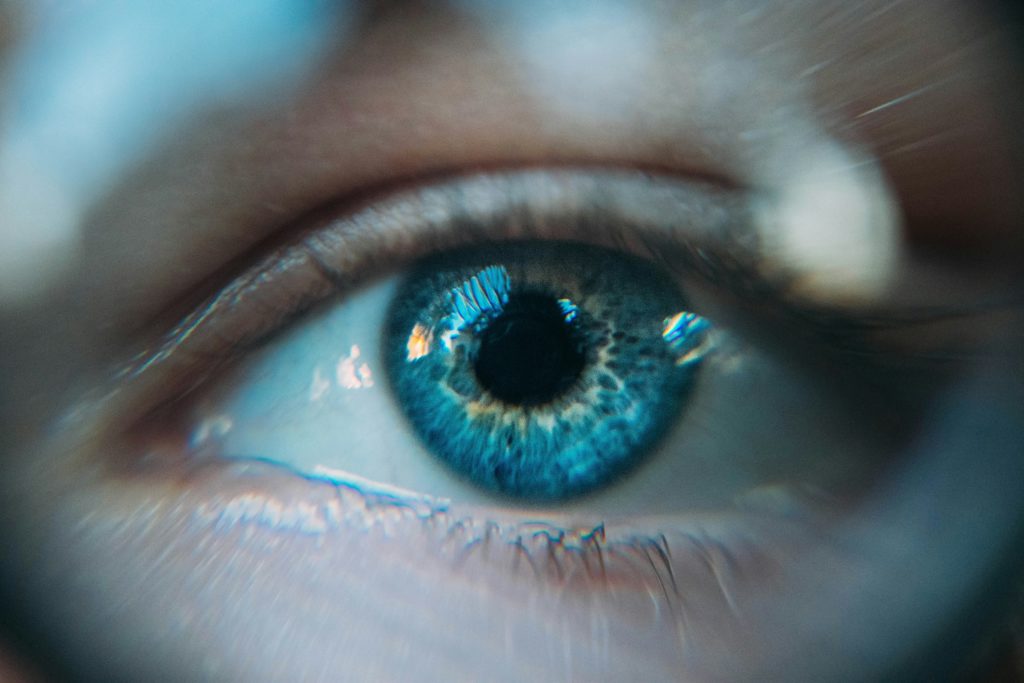
However, if someone has astigmatism, either the cornea or lens is shaped more like a rugby ball or an egg. This irregular shape causes light to be refracted (bent) at two different angles, resulting in blurry or distorted vision.
Causes and Symptoms of Astigmatism
The exact cause of astigmatism isn’t always clear. Many people are born with it, while others develop it during childhood or young adulthood. In some cases, it can occur after eye surgery or injury.
There’s also a condition called keratoconus, a progressive eye disease where the cornea thins and bulges into a cone-like shape, which can cause severe astigmatism.
The symptoms of astigmatism can vary, but common signs include:
1. Blurry or distorted vision at all distances
2. Headaches
3. Eye strain
4. Squinting
5. Difficulty seeing clearly at night
6. Needing glasses for both near and distant vision
Anyone experiencing any of these symptoms should have a comprehensive eye examination. Even if the symptoms are not caused by astigmatism, they could be the result of another ocular issue that could be resolved with glasses or contact lenses.
The good news is that astigmatism is highly treatable. There are three main approaches to correcting astigmatism: glasses, contact lenses, and surgery.
Glasses
For many people with astigmatism, especially those with mild to moderate cases, glasses are the first line of treatment. The lenses in these glasses are specially designed to counteract the irregular shape of the cornea or lens, allowing light to focus correctly on the retina. This correction reduces blurriness and distortion, alleviating symptoms like headaches and eye strain.
Glasses are a quick, safe, and non-invasive option that can provide immediate improvement in vision. They’re particularly suitable for children, whose eyes are still developing, and for adults with milder astigmatism who prefer a simple solution.
Contact Lenses
Much like glasses, contact lenses can also effectively correct astigmatism. There are several types of contact lenses available for people with astigmatism:
- Toric soft contact lenses: These lenses have different powers in different meridians of the lens to correct the astigmatism.
- Gas permeable contact lenses: These rigid lenses maintain their shape on the eye, which can help correct astigmatism.
- Hybrid contact lenses: These combine a rigid centre with a soft outer ring, providing the clarity of a gas permeable lens with the comfort of a soft lens.
Contact lenses can be an excellent option for those who don’t want to wear glasses or need vision correction during sports or other activities where glasses might be impractical.
Surgical Options
For those seeking a more permanent solution, or for whom glasses and contacts aren’t suitable, several surgical options are available to correct astigmatism:
Laser Eye Surgery
Refractive surgery uses a laser to reshape the cornea, correcting the refractive error. There are several types of laser eye surgery that can treat astigmatism:
- LASIK (Laser-Assisted In Situ Keratomileusis): This popular procedure involves creating a thin flap in the cornea, using a laser to reshape the underlying corneal tissue, and then repositioning the flap.
- LASEK (Laser-Assisted Subepithelial Keratectomy): Instead of creating a flap, the surgeon loosens the cornea’s thin protective cover (epithelium) with a special alcohol, reshapes the cornea with a laser, and then repositions the epithelium.
- PRK (Photorefractive Keratectomy): Similar to LASEK, but the epithelium is removed entirely and allowed to grow back naturally, conforming to the cornea’s new shape.
- Epi-LASIK: This procedure uses a special mechanised blunt blade to separate a very thin sheet of epithelium before reshaping the cornea with a laser.
- SMILE (Small-Incision Lenticule Extraction): This newer technique reshapes the cornea by creating a small lens-shaped bit of tissue (lenticule) below the cornea’s surface, which is then removed through a tiny incision.
Astigmatic Keratotomy (AK)
This procedure involves making microscopic incisions in the steeper meridian of the cornea. These incisions cause the cornea to assume a more spherical shape, reducing the degree of astigmatism.
Cataract Surgery with Astigmatism Correction
For patients with both cataracts and astigmatism, there are options to address both issues during cataract surgery:
- Opposite Clear Corneal Incisions (OCCI): In addition to the incision made to treat the cataract, another incision is made on the opposite side to simultaneously correct astigmatism.
- Toric Intraocular Lenses (IOLs): These specially designed lenses can be implanted during cataract surgery to correct astigmatism. For private patients, advanced options like Extended Depth of Focus (EDOF) lenses are available, which can correct both near and distance vision, while the NHS only offers standard lenses. Private treatment may be available through private healthcare insurance but the EDOF lens often comes at an additional cost.
Surgical Process: What to Expect
For anyone considering surgical correction for astigmatism, here’s what to expect:
1. Referral and Consultation: Patients are typically referred by an optician or GP. During the consultation, the eye surgeon will assess the patient’s suitability for different surgical options based on the severity of the astigmatism, age, overall health, and other factors.
2. Preparation: The surgeon will review the patient’s medical history, including any medications they are taking. Some medications can affect pupil dilation or increase the risk of bleeding, so it’s crucial to provide a complete drug history.
3. The Procedure: On the day of surgery, the surgeon will explain the process step-by-step to ease any anxiety. The eye will be cleaned and held open with a small clip. The patient will be asked to look at a bright light, and numbing drops will be applied. While the patient may still have some sensation, they shouldn’t feel pain. The procedure itself is typically quite quick, often taking only 6-8 minutes.
4. Recovery: Most patients start to see improvements in their vision within the first week, with significant improvements typically occurring after about two weeks.
5. Follow-up: Patients need to see their optician 4-5 weeks after the procedure to check the outcome. At Midland Eye, we offer additional surgery for extreme astigmatism if needed.
Post-Surgery Expectations and Tips
After surgery, many patients find they no longer need to wear thick glasses all the time. While they may still need reading glasses (especially with standard NHS lenses), overall vision should be significantly improved. Private patients who opt for EDOF lenses may not need glasses at all.
It’s important to note that some procedures, like AK or OCCI, can initially cause a gritty, dry feeling in the eye. Using artificial teardrops can help alleviate this discomfort.
The benefits of astigmatism correction surgery typically last a lifetime, with most patients not requiring further surgeries. However, it’s still important to have regular eye check-ups to monitor overall eye health.
ABOUT THE AUTHOR
Ramesh Sivaraj is an Ocular Consultant at Midland Eye, which was founded by four ophthalmic surgeons who wanted to provide patients with a comprehensive, specialist service for the diagnosis and treatment of all eye conditions. The Midland Eye team are leaders in their field and offer a consultant-only service to all patients requiring eye care or surgery. Every consultant is qualified to treat common eye conditions such as cataracts but each one also has a particular area of specialisation, ensuring that patients get the best possible outcome, no matter what the diagnosis.
